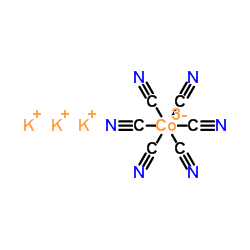Potassium hexacyanocobaltate

Potassium hexacyanocobaltate structure
|
Common Name | Potassium hexacyanocobaltate | ||
|---|---|---|---|---|
| CAS Number | 13963-58-1 | Molecular Weight | 332.332 | |
| Density | 1.878 g/mL at 25 °C(lit.) | Boiling Point | 25.7ºC at 760mmHg | |
| Molecular Formula | C6CoK3N6 | Melting Point | N/A | |
| MSDS | Chinese USA | Flash Point | N/A | |
| Symbol |

GHS07 |
Signal Word | Warning | |
| Name | Potassium hexacyanocobaltate(III) |
|---|---|
| Synonym | More Synonyms |
| Density | 1.878 g/mL at 25 °C(lit.) |
|---|---|
| Boiling Point | 25.7ºC at 760mmHg |
| Molecular Formula | C6CoK3N6 |
| Molecular Weight | 332.332 |
| Exact Mass | 331.842773 |
| PSA | 142.74000 |
| LogP | 0.10068 |
| Stability | Stable. Incompatible with strong oxidizing agents. |
| Water Solubility | soluble |
CHEMICAL IDENTIFICATION
HEALTH HAZARD DATAACUTE TOXICITY DATA
|
| Symbol |

GHS07 |
|---|---|
| Signal Word | Warning |
| Hazard Statements | H302 |
| Precautionary Statements | P301 + P312 + P330 |
| Hazard Codes | T:Toxic; |
| Risk Phrases | R22;R32;R33 |
| Safety Phrases | S28-S36/37-S45-S7/9-S24/25 |
| RIDADR | UN 1588 6.1/PG 2 |
| WGK Germany | 3 |
| RTECS | GF9470000 |
| Packaging Group | III |
| Hazard Class | 6.1(b) |
| HS Code | 2926909090 |
| HS Code | 2926909090 |
|---|---|
| Summary | HS:2926909090 other nitrile-function compounds VAT:17.0% Tax rebate rate:9.0% Supervision conditions:none MFN tariff:6.5% General tariff:30.0% |
|
An NMR study of anion binding to yeast phosphoglycerate kinase.
Eur. J. Biochem. 190(1) , 161-9, (1990) Anion binding to yeast phosphoglycerate kinase has been investigated using 1H-NMR spectroscopy. The use of anionic paramagnetic probes. [Cr(CN)6]3- and [Fe(CN)6]3-, has enabled the location of the pri... |
|
|
The modulation of cytochrome c electron self-exchange by site-specific chemical modification and anion binding.
FEBS Lett. 206(1) , 15-9, (1986) The site-specific chemical modification of horse heart cytochrome c at Lys-13 and -72 using 4-chloro-3,5-dinitrobenzoic acid (CDNB) increases the electron self-exchange rate of the protein. In the pre... |
|
|
Toxicity of cobalt-complexed cyanide to Oncorhynchus mykiss, Daphnia magna, and Ceriodaphnia dubia. Potentiation by ultraviolet radiation and attenuation by dissolved organic carbon and adaptive UV tolerance.
Environ. Sci. Pollut. Res. Int. 14(5) , 333-7, (2007) Cobalt cyanide complexes often result when ore is treated with cyanide solutions to extract gold and other metals. These have recently been discovered in low but significant concentrations in effluent... |
| Cobaltate (3-), hexacyano-, tripotassium |
| Potassium hexacyanocobaltate |
| MFCD00011391 |
| Tripotassium hexakis(cyano-κC)cobaltate(3-) |
| Potassium cobaltihexacyanide |
| Cobaltate(3-), hexakis(cyano-κC)-, potassium (1:3) |
| COBALT POTASSIUM CYANIDE |
| Potassium hexacyanocobaltate(3-) |
| POTASSIUM COBALTICYANIDE |
| Tripotassium hexacyanocobaltate(3-) |
| potassiumcobalticyanine |
| Cobaltate(3-), hexacyano-, tripotassium |
| Tripotassium hexacyanocobaltate (3-) |
| Tripotassium hexacyanocobaltate |
| EINECS 237-742-1 |

